Chapter 12. Canada at the End of History
12.8 The Art of War
The invention of the smartphone has created the most photographed generation in history. Perhaps it is difficult to recall, as a consequence, how rare and special visual and audio images were in the past. The technology necessary to the creation and dissemination of photography and recordings was only just coming into being at the time of Confederation. Whereas, with very scarce exceptions, the pre-Confederation era was recorded on canvas, the post-Confederation period would be preserved in great variety of ways. Visual artifacts, therefore, constitute multiple histories: evidence of what they ostensibly document, evidence of changes in styles, evidence of evolving audiences and tastes, and evidence of changes in the technologies of representation, reproduction, and dissemination.
The late 19th century saw the rise of poster-art, as new printing technologies met new styles. The art nouveau movement gave way to Art Deco and, in between, commercial art became a growing part of an embryonic consumer economy. Whether for vaudeville or for serious theatre, CPR hotels or new household products, posters became increasingly colourful, far less fussy, and powerfully expressive.
Recruitment posters for the Great War remain iconic a century later. In the United Kingdom, Lord Kitchener’s face was so familiar to the public that his name was left out of the phrase “Wants You.” The Americans subsequently borrowed the stern look and the pointing finger for their famous “Uncle Sam Wants You” poster that came out in 1917. In Canada, the war imagery started in a jolly mood with a sense of adventure and little sense of actual fighting or danger (Figure 12.20).

As the war dragged on the messages and images changed. A psychological approach appeared, one in which men were shamed into enlisting or their women encouraged to give them a push (Figure 12.21).

Appeals were made, too, to ethnic groups. The relationship between the Irish and the British was fraught during the Great War but that didn’t stop Canadian recruiters from imposing their expectations of loyalism on the Irish-Canadian community (Figure 12.22).
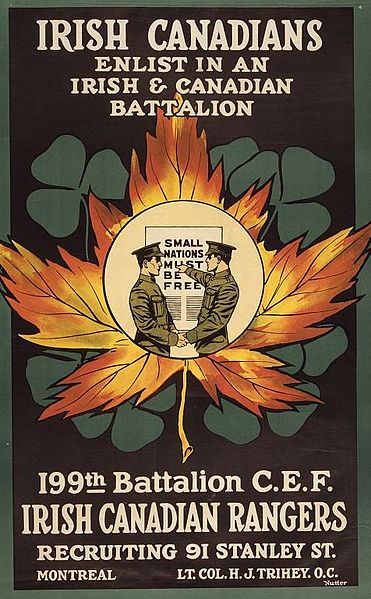
The same could be said for Canadian Jews, whose experience of Christian-Canadian tolerance included Clifford Sifton’s efforts to keep them out of the country entirely from 1896 to 1906. The emancipation (removal of civil restrictions and barriers to public service based on faith) of the Jews in Britain in 1858 is echoed here (Figure 12.23) as the warrior-to-be announces, “You have cut my bonds and set me free — Now let me help you set others FREE!”
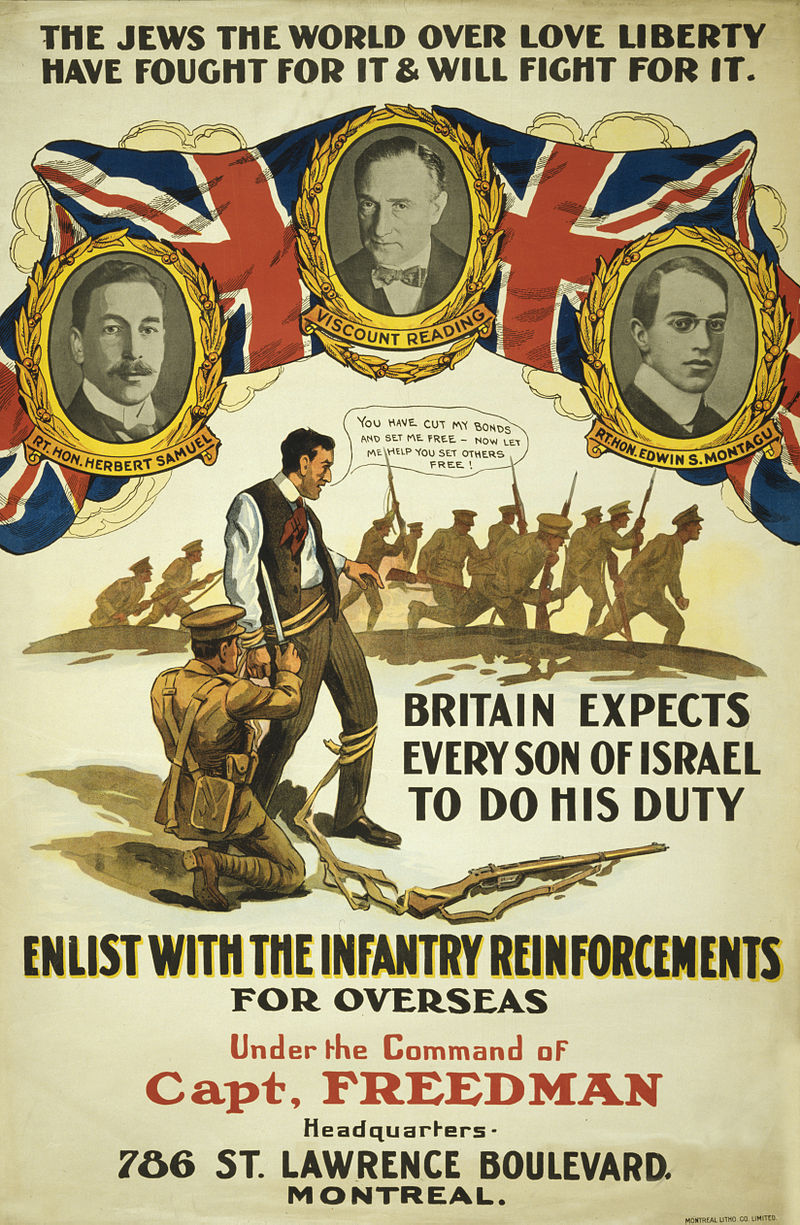
The artwork itself was evolving: 20th-century lettering and aerial combat, along with an entirely different representative style makes an appearance in this 1916 poster (Figure 12.24).
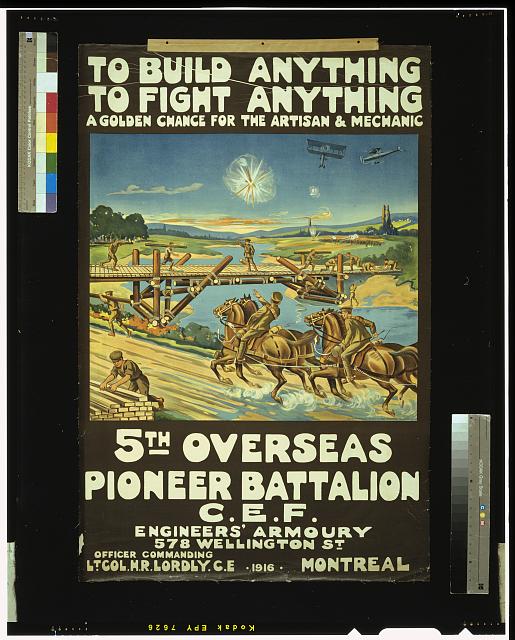
If recruitment posters could not do the job, then Victory Bonds might. The range of Victory Bond posters is staggering, and their complexity and colours are striking (Figure 12.25).
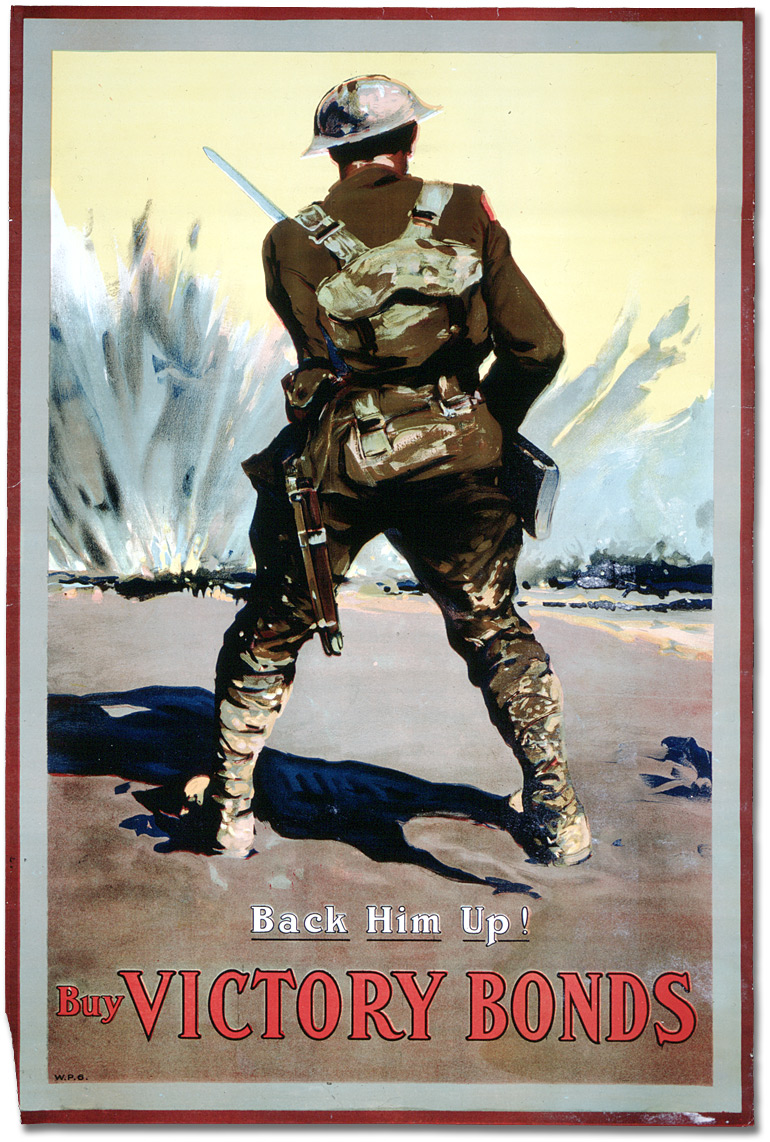
Images of children were conscripted to the task of selling Victory Bonds. A famous version of this was the British “What did you do during the Great War, Daddy?” poster (Figure 12.26).
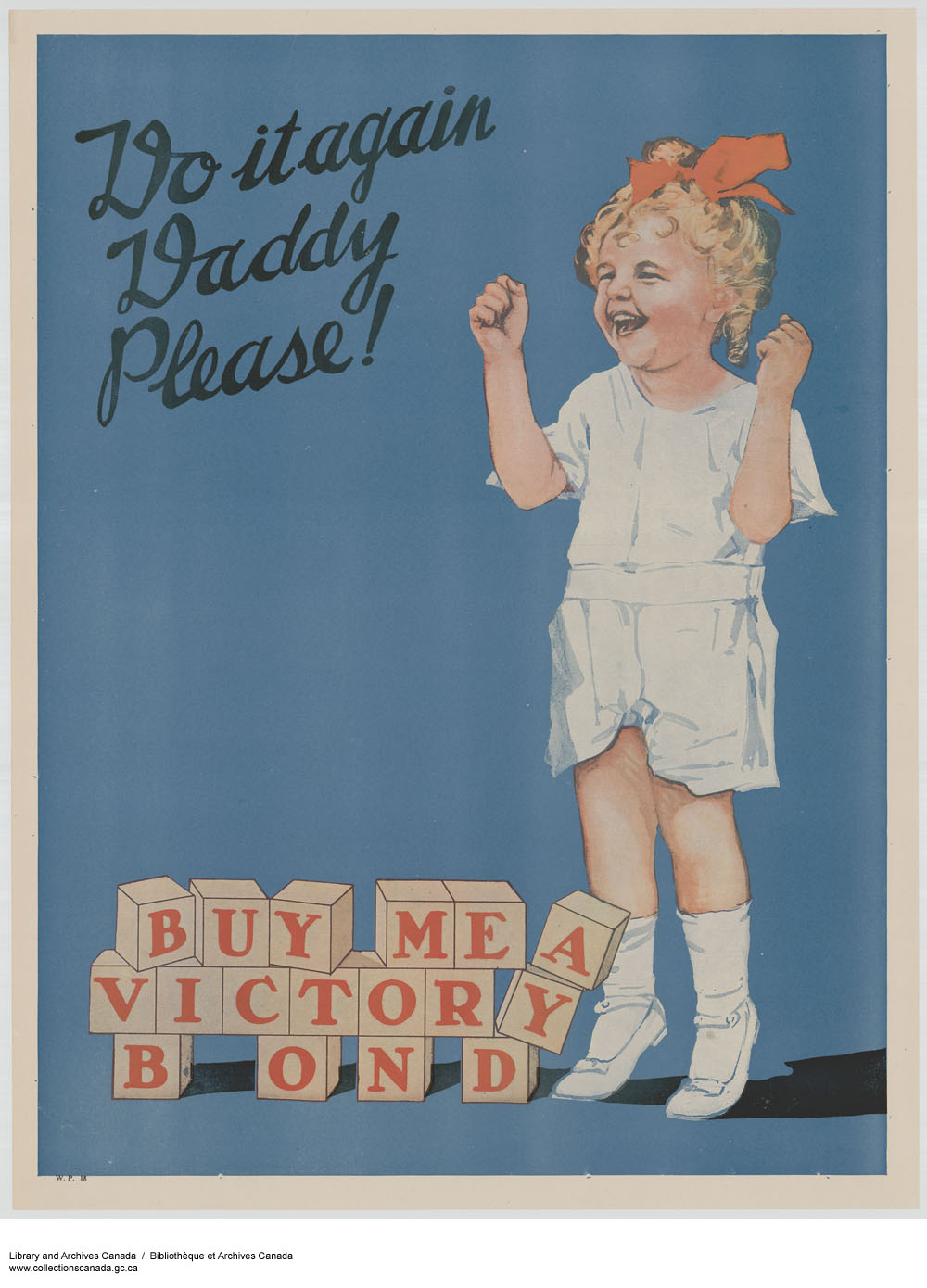
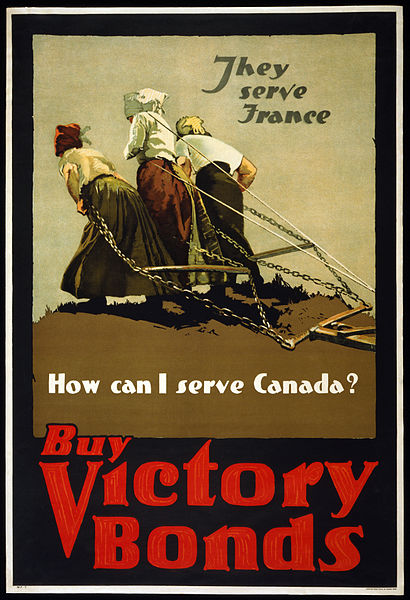
Even at war’s end, the posters continued to appear, calling for citizens’ help to reintegrate the returning soldier (Figure 12.28).
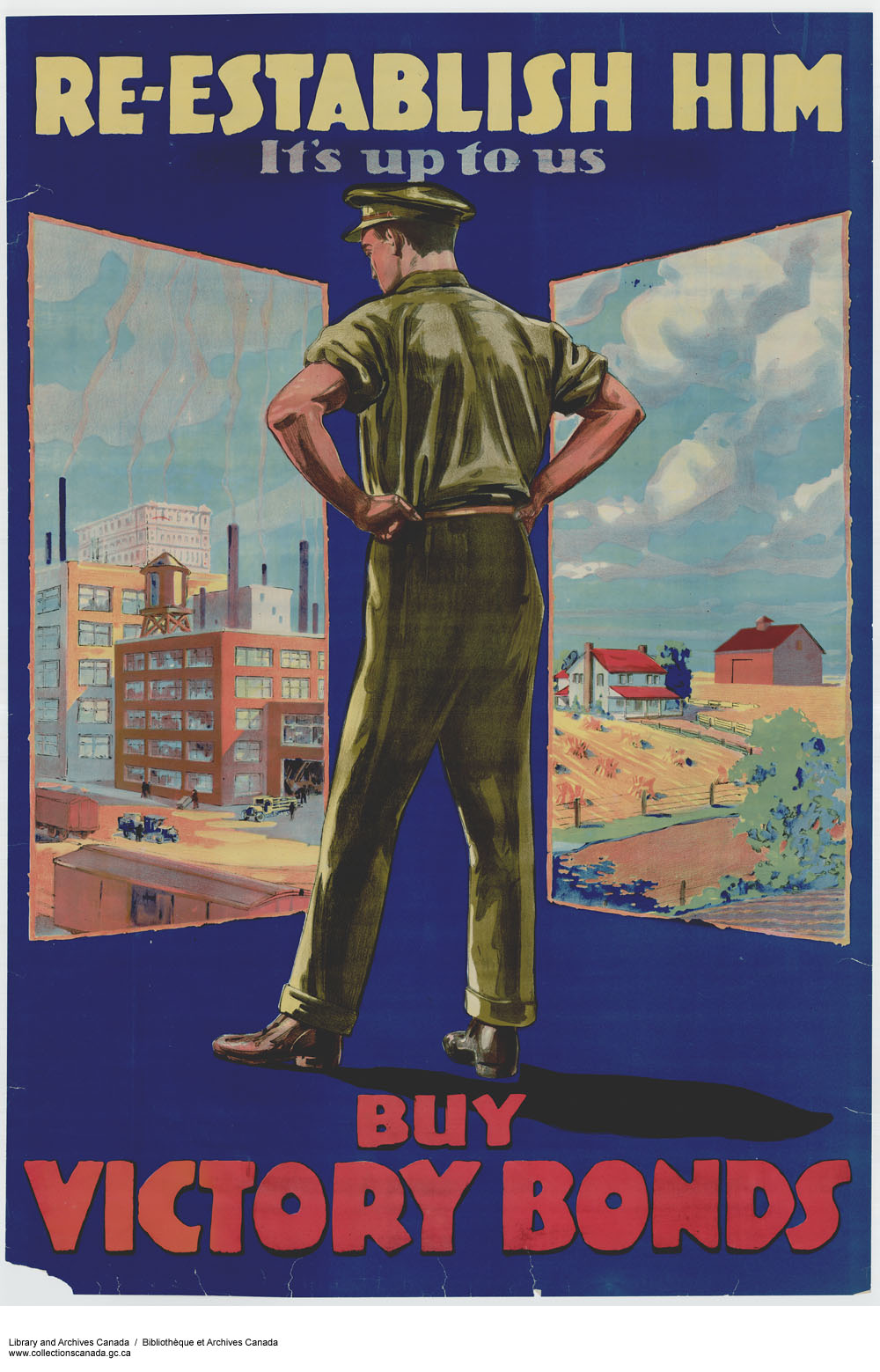
Modern artistic styles become more obvious in this 1919 painting by Frederick Etchells, Armistice Day, Munitions Centre (Figure 12.29).
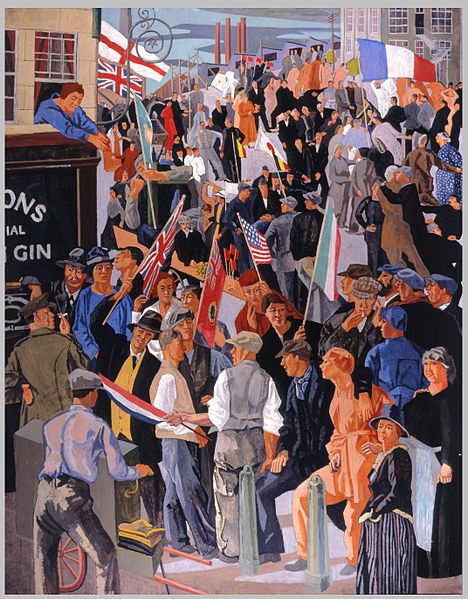
By the outbreak of World War II, Canadian art had become more mature and sophisticated. The Group of Seven were by now well established (see Section 10.14). One of their number — A.J. Casson — produced this glorious work as the collection of donations for a new generation of Victory Bonds, which got underway in 1941 (Figure 12.30).
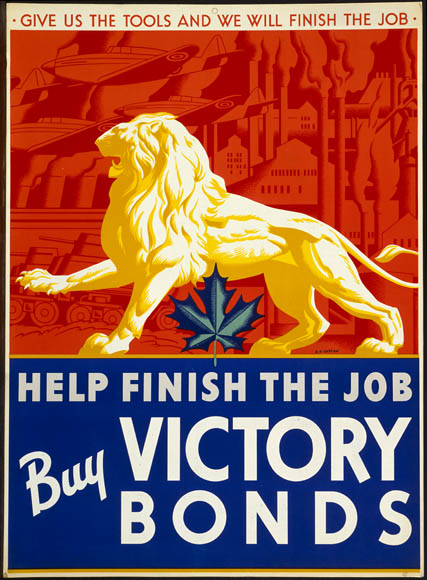
Art-deco-meets-gothic-knights in this Department of National Defense recruitment poster (Figure 12.31).
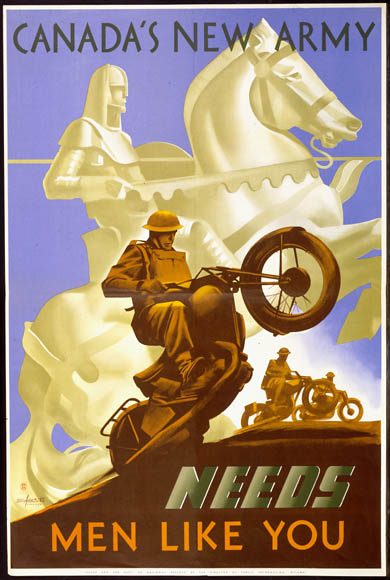
Wartime brought a variety of moral panics, including fear of spies, saboteurs, slackers, and sexually transmitted diseases. The last of these became associated with “loose women” and prostitutes, rather than with enlisted men. Campaigns against venereal diseases often portrayed women as infectious sexual predators who were sapping the strength of the nation (Figure 12.32).
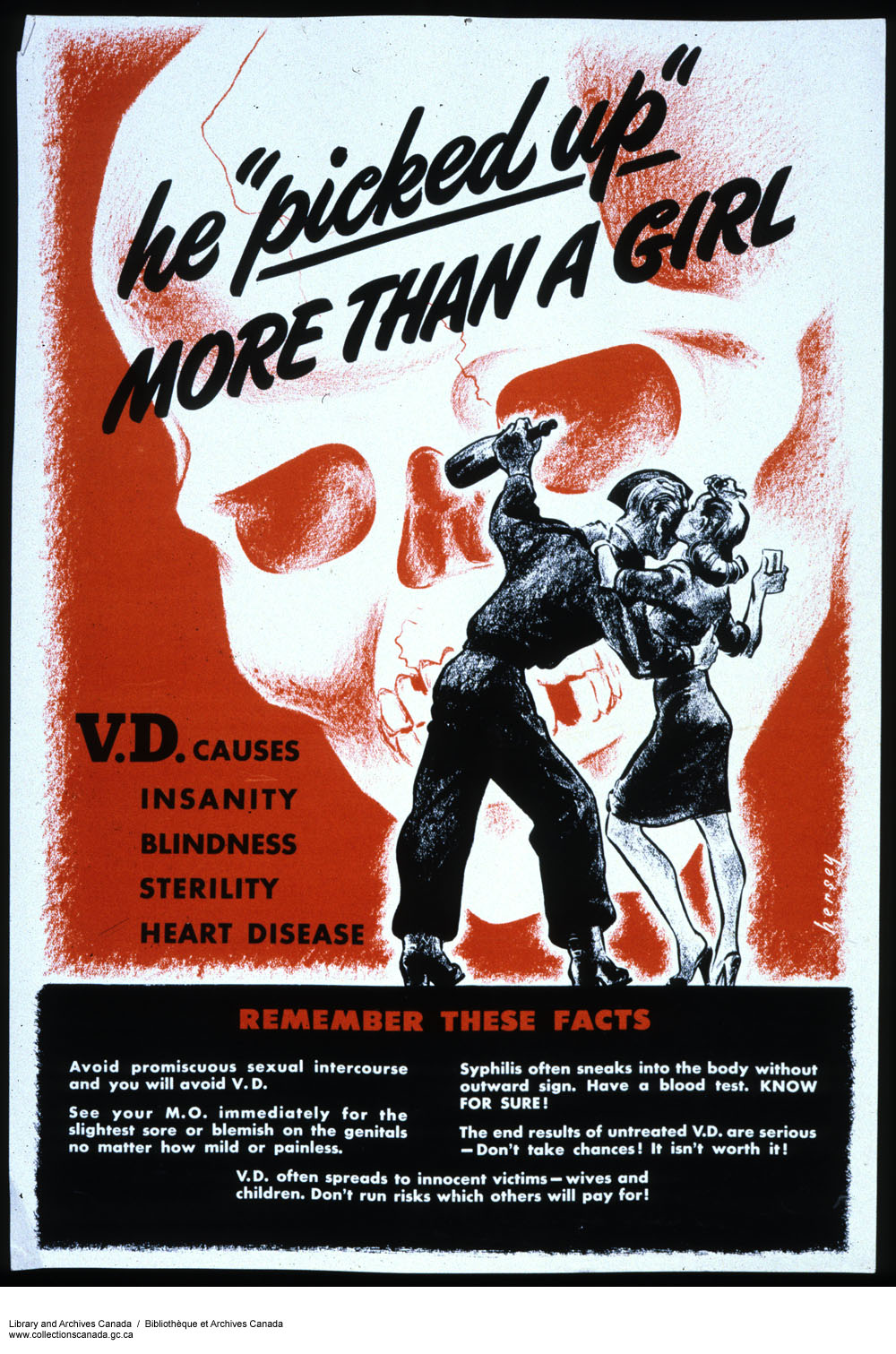
The final word goes to the Wartime Information Board, who deployed strong colours and graphics in service of the newest Victory Bonds campaign (Figure 12.33).
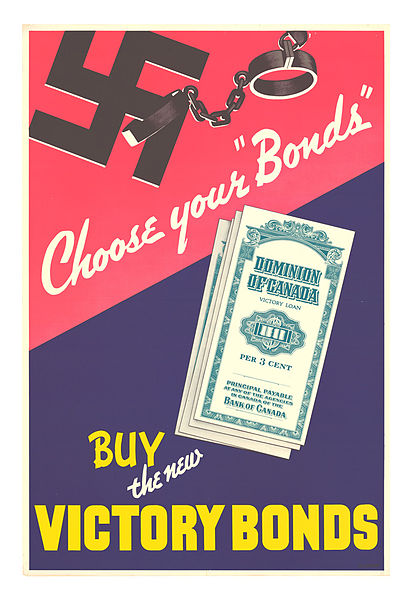
Art histories of the 20th century generally don’t provide much space for these utilitarian creations but histories of social and cultural values should. These are documents that show us the past, while shaping the past at the same time.
Key Points
- Posters became both a cultural form and an important means of communicating values, goals, and other messages in the 20th century, as the poster-art of Canada at war reveals.
Long Descriptions
Figure 12.20 long description: A French-language French Canadian recruitment poster for World War I. It shows a uniformed soldier, one hand on a rifle, the other raised in victory. He smiles. The poster says “Canadiens Francais: enrolez-vous au 150ieme Carabiniers Mont Royal sous le commandement du Lt. Colonel H. Barré. Un regiment d’elite compose d’hommes de choix, et commande par des officiers d’experience revenus du front de la guerre. Bureau de recrutement, arsenal du 65ieme regiment, Coin Avenue des pins et Rue Henri Julien, Montreal.” [Return to Figure 12.20]
Figure 12.21 long description: Poster addressed “to the women of Canada.” It is numbered, and lists its points as such:
- You have read what the Germans have done in Belgium. Have you thought what they would do if they invaded this Country?
- Do you realize that the safety of your home and children depends on our getting more men NOW?
- Do you realize that the one word “GO” from you may send another man to fight for our King and Country?
- When the War is over and someone asks your husband or your son what he did in the Great War, is he to hang his head because you would not let him go?
The bottom reads “Won’t you help and send a man to enlist to-day?” [Return to Figure 12.21]
Figure 12.22 long description: Recruitment poster depicting two men in uniforms standing in front of a poster that says “Small Nations Must Be Free.” These men are in a circle, which is over a flame-coloured maple leaf, which is over four clovers. The top of the poster says “Irish Canadians: Enlist in an Irish & Canadian Battalion.” The bottom of the poster says “199th Battalion C.E.F., Irish Canadian Rangers. Recruiting 91 Stanley St., Montreal. Lieutenant Colonel H.J. Trihey, Order of Canada.” [Return to Figure 12.22]
Figure 12.23 long description: Recruitment poster for Jewish Canadians. It shows the portraits of the Right Honorable Herbert Samuel, Viscount Reading, and the Right Honorable Edwin S. Montagu in gold laurel frames, splayed across a Union Flag. Above their pictures are the words “The Jews the world over love liberty, have fought for it & will fight for it.” Beneath the pictures is a group of soldiers, running into battle with their rifles held aloft. One soldier undoes the ropes around a man in a vest and ascot. The man says, “You have cut my bonds and set me free—now let me help you set others free!” He looks to the soldiers running past.
Beside these men are the words “Britain expects every son of Israel to do his duty.” Beneath them, it says “Enlist with the infantry reinforcements for overseas. Under the Command of Captain Freedman. Headquarters, 786 St. Lawrence Boulevard, Montreal.” [Return to Figure 12.23]
Figure 12.24 long description: Recruitment poster showing men on horses charging into battle. In the distance are men building a bridge, men carrying lumber. The poster says “To build anything, to fight anything: A golden chance for the artisan & mechanic. 5th Overseas Pioneer Battalion C.E.F. Engineers’ Armoury, 578 Wellington St. Officer Commanding: Lieutenant Colonel M.R. Lordly, C.E. 1916, Montreal.” [Return to Figure 12.24]
Figure 12.30 long description: Poster advertising victory bonds. It shows a golden lion, teeth bared, above a blue maple leaf. Behind these symbols are factories, war planes, and tanks. At the top of the poster, it says “Give us the tools and we will finish the job.” At the bottom, it says “Help finish the job—Buy victory bonds.” [Return to Figure 12.30]
Figure 12.31 long description: A World War II soldier pops a wheelie on a motorcycle on dirt or sand. In the distance, two other soldiers are on motorcycles. Behind all of them, enlarged and pale to indicate the past, is a medieval soldier wearing armour, a full face helmet, and riding a horse. The poster’s text reads “Canada’s new army NEEDS men like you.” [Return to Figure 12.31]
Figure 12.32 long description: Poster warning against venereal disease. It shows a soldier holding a bottle and a woman holding a glass, hugging each other and getting close together. Looming behind them is a giant skull with the words “he ‘picked up’ more than a girl” over it. The poster continues “V.D. causes insanity, blindness, sterility, heart disease.”
“Remember these facts: Avoid promiscuous sexual intercourse and you will avoid V.D. [venereal disease].”
“See your M.O. [medical officer] immediately for the slightest sore or blemish on the genitals no matter how mild or painless.”
“Syphilis often sneaks into the body without outward sign. Have a blood test. KNOW FOR SURE!”
“The end results of untreated V.D. are serious—Don’t take chances! It isn’t worth it!”
“V.D. often spreads to innocent victims—wives and children. Don’t run risks which others will pay for!” [Return to Figure 12.32]
Figure 12.33 long description: A poster advertising victory bonds. A swastika is attached to a shackle above the words “Choose your ‘Bonds.'” Below is an image of a government bond paper. The paper says “Dominion of Canada victory loan. Per 3 cent. Principal payable at any of the agencies in Canada of the Bank of Canada.” Below that, it says “Buy the new victory bonds.” [Return to Figure 12.33]
Media Attributions
- Canadiens français (between 1914 and 1918) © Archives of Ontario, I0016177 is licensed under a Public Domain license
- Bring Him Home with the Victory Loan, ca. 1918 © Archives of Ontario, I0016138 is licensed under a Public Domain license
- Irish Canadians enlist in an Irish and Canadian Battalion is licensed under a Public Domain license
- The Jews the world over love liberty © Montreal Litho. Co. is licensed under a Public Domain license
- To build anything, to fight anything … 5th Overseas Pioneer Battalion, C.E.F. © Library of Congress (POS - CAN .A01, no. 49 (C size) [P&P]) is licensed under a Public Domain license
- Back Him Up! Buy Victory Bonds, ca. 1918 © Archives of Ontario, I0016140 is licensed under a Public Domain license
- Do It Again Daddy Please! Buy Me a Victory Bond © Library and Archives Canada (MIKAN no. 3667091) is licensed under a Public Domain license
- Canada WWI Victory Bonds © Library of Congress Prints and Photographs (LC-USZC4-10650) is licensed under a Public Domain license
- Re-establish Him – It’s up to us – Buy victory bonds © Library and Archives Canada (MIKAN no. 3635524) is licensed under a Public Domain license
- Frederick Etchells – Armistice Day, Munitions Centre © Frederick Etchells is licensed under a Public Domain license
- Give Us the Tools © Library and Archives Canada (MIKAN no. 2834370) is licensed under a Public Domain license
- Canada’s New Army – Needs Men Like You, 1942 © Eric Aldwinckle, Albert Cloutier, Library and Archives Canada (MIKAN no. 2834359) is licensed under a Public Domain license
- He “Picked Up” More Than a Girl : sensitive campaign against venereal disease © Harry Mayerovitch, Library and Archives Canada (MIKAN no. 2851781) is licensed under a Public Domain license
- Choose Your Bonds. Buy the New Victory Bonds © Department of National Defence, Ottawa is licensed under a Public Domain license

